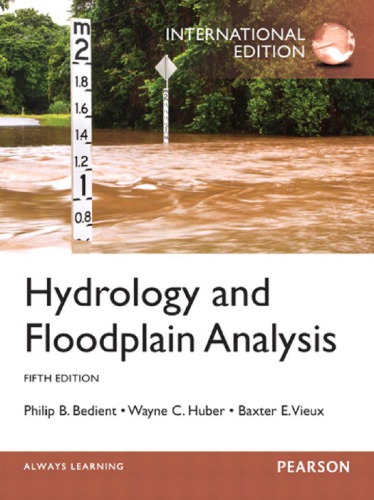

Most ebook files are in PDF format, so you can easily read them using various software such as Foxit Reader or directly on the Google Chrome browser.
Some ebook files are released by publishers in other formats such as .awz, .mobi, .epub, .fb2, etc. You may need to install specific software to read these formats on mobile/PC, such as Calibre.
Please read the tutorial at this link: https://ebookbell.com/faq
We offer FREE conversion to the popular formats you request; however, this may take some time. Therefore, right after payment, please email us, and we will try to provide the service as quickly as possible.
For some exceptional file formats or broken links (if any), please refrain from opening any disputes. Instead, email us first, and we will try to assist within a maximum of 6 hours.
EbookBell Team

4.8
94 reviews 
ISBN 10: 0273774271
ISBN 13: 978-0273774273
Author: Philip Bedient
For undergraduate and graduate courses in Hydrology. This text offers a clear and up-to-date presentation of fundamental concepts and design methods required to understand hydrology and floodplain analysis. It addresses the computational emphasis of modern hydrology and provides a balanced approach to important applications in watershed analysis, floodplain computation, flood control, urban hydrology, stormwater design, and computer modeling.
Chapter 1: Hydrologic Principles
1.1 Introduction to Hydrology
1.2 Weather Systems
1.3 Precipitation
1.4 The Hydrologic Cycle
1.5 Simple Rainfall-Runoff
1.6 Streamflow and the Hydrograph
1.7 Hydrograph Analysis
1.8 Hydrologic Measurement
Chapter 2: Hydrologic Analysis
2.1 Watershed Concepts
2.2 Unit Hydrograph Theory
2.3 Synthetic Unit Hydrograph Development
2.4 Applications of Unit Hydrographs
2.5 Linear and Kinematic Wave Models
2.6 Hydrologic Loss — Evaporation and ET
2.7 Hydrologic Loss — Infiltration
2.8 Green and Ampt Infiltration Method
2.9 Snowfall and Snowmelt
Chapter 3: Frequency Analysis
3.1 Introduction
3.2 Probability Concepts
3.3 Random Variables and Probability Distributions
3.4 Return Period or Recurrence Interval
3.5 Common Probabilistic Models
3.6 Graphical Presentation of Data
3.7 Regional Analysis
3.8 Related Topics
Chapter 4: Flood Routing
4.1 Hydrologic and Hydraulic Routing
4.2 Hydrologic River Routing
4.3 Hydrologic Reservoir Routing
4.4 Governing Equations for Hydraulic River Routing
4.5 Movement of a Flood Wave
4.6 Kinematic Wave Routing
4.7 Hydraulic River Routing
Chapter 5: Hydrologic Simulation Models
5.1 Introduction to Hydrologic Models
5.2 Steps in Watershed Modeling
5.3 Description of Major Hydrologic Models
5.4 HEC-HMS Flood Hydrograph Theory
5.5 Application of HEC-HMS to Watersheds
5.6 HEC-HMS Watershed Analysis: Case Study
Chapter 6: Urban Hydrology
6.1 Characteristics of Urban Hydrology
6.2 Review of Physical Processes
6.3 Rainfall Analysis in Urban Basins
6.4 Methods for Quantity Analysis
6.5 Sewer System Hydraulics
6.6 Control Options
6.7 Operational Computer Models
6.8 Case Study
Chapter 7: Floodplain Hydraulics
7.1 Uniform Flow
7.2 Uniform Flow Computations
7.3 Specific Energy and Critical Flow
7.4 Occurrence of Critical Depth
7.5 Nonuniform Flow or Gradually Varied Flow
7.6 Gradually Varied Flow Equations
7.7 Classification of Water Surface Profiles
7.8 Hydraulic Jump
7.9 Introduction to the HEC-RAS Model
7.10 Theoretical Basis for HEC-RAS
7.11 Basic Data Requirements (Steady State)
7.12 Optional HEC-RAS Capabilities
7.13 Bridge Modeling in HEC-RAS
7.14 HEC-RAS Features
Chapter 8: Ground Water Hydrology
8.1 Introduction
8.2 Properties of Ground Water
8.3 Ground Water Movement
8.4 Flow Nets
8.5 General Flow Equations
8.6 Dupuit Equation
8.7 Streamlines and Equipotential Lines
8.8 Unsaturated Flow
8.9 Steady-State Well Hydraulics
8.10 Unsteady Well Hydraulics
8.11 Water Wells
8.12 Ground Water Modeling Techniques
Chapter 9: Design Applications in Hydrology
9.1 Introduction
9.2 Drainage Collection Systems
9.3 Design of Culverts
9.4 Detention Basins Used to Mitigate Project Impacts
9.5 Floodplain Management Design Issues
Chapter 10: GIS Applications in Hydrology
10.1 Introduction to GIS
10.2 General GIS Concepts
10.3 Digital Representation of Hydrologic Parameters
10.4 Digital Representation of Topography
10.5 GIS-Based Hydrology and Hydraulics
10.6 Common GIS Software Programs
Chapter 11: Radar Rainfall Applications in Hydrology
11.1 Introduction
11.2 Radar Estimation of Rainfall
11.3 NEXRAD (WSR-88D) Radar System
11.4 Gage Adjustment of Radar
11.5 Hydrologic Applications
Chapter 12: Severe Storm Impacts and Flood Management
12.1 Introduction
12.2 Flood Management Issues and Basic Terminology
12.3 Structural and Nonstructural Methods of Flood Control
12.4 The Flood Control Paradox
12.5 Major Gulf Hurricanes: Katrina and Ike
12.6 Improved Strategies Toward Flood Management
Chapter 13: Case Studies in Hydrologic Engineering: Water Resource Projects
13.1 Introduction
13.2 The City of San Antonio — Deep in the Heart of Texas
13.3 The Colorado River — Taming the Wild West
13.4 Across the Pond — The River Thames
13.5 Global Climate Change and Water
hydrology and floodplain analysis 6th edition pdf
bedient hydrology and floodplain analysis 6e
hydrology and floodplain analysis 6th edition
hydrology and floodplain analysis 6th edition pdf free download
hydrology and floodplain analysis pdf
Tags: Philip Bedient, Hydrology, Floodplain, Analysis